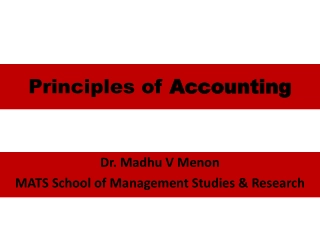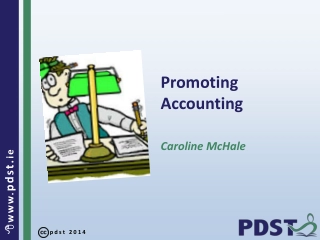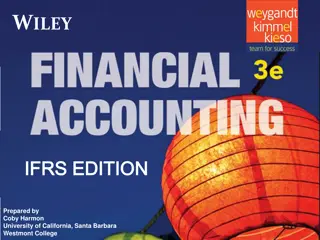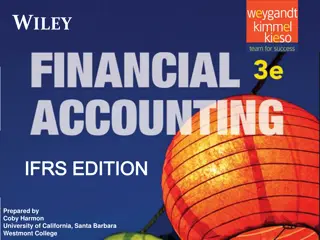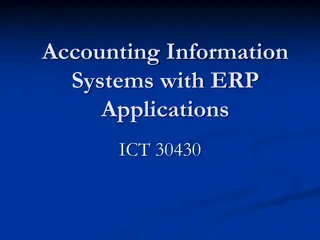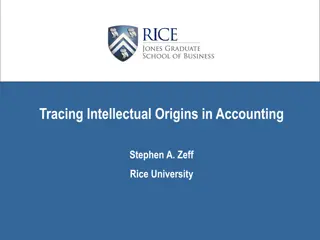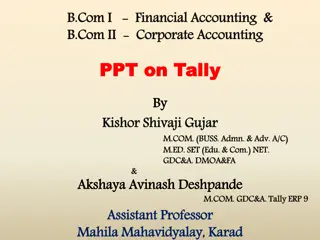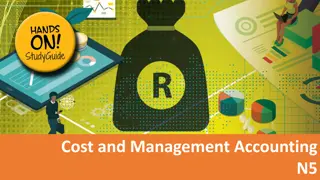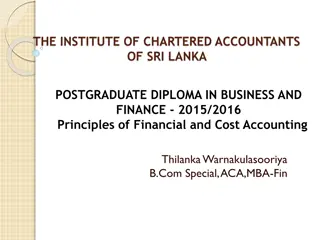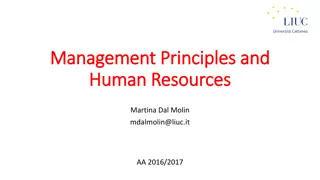
Financial Accounting for Partnerships and Branches
"Explore the legal aspects, accounting cycle, financial statements, and more in partnerships, with insights into the aims of establishing branches. Learn how partnerships operate and appropriate profits, along with the financial aspects of loans given to the partnership."
Download Presentation

Please find below an Image/Link to download the presentation.
The content on the website is provided AS IS for your information and personal use only. It may not be sold, licensed, or shared on other websites without obtaining consent from the author. If you encounter any issues during the download, it is possible that the publisher has removed the file from their server.
You are allowed to download the files provided on this website for personal or commercial use, subject to the condition that they are used lawfully. All files are the property of their respective owners.
The content on the website is provided AS IS for your information and personal use only. It may not be sold, licensed, or shared on other websites without obtaining consent from the author.
E N D
Presentation Transcript
Module 1 Partnerships LEGAL ASPECTS A partnership as a form of business is created by a verbal or written agreement between two or more natural persons, but not more than twenty, to place their money, goods, labour and personal ability into a lawful business. Their aim will be to make a profit and to share such profit or losses amongst themselves according to a partnership agreement. www.futuremanagers.com
Module 1 Partnerships (continued) ACCOUNTING CYCLE OF A PARTNERSHIP The accounting cycle of a partnership is the same as that of a sole trader. The only difference is an additional final account, called the appropriation account, which is used to appropriate the profits or losses according to the partnership agreement. www.futuremanagers.com
Module 1 Partnerships (continued) LOANS BY PARTNERS TO THE PARTNERSHIP Partners, in their personal (private) capacity, can make a loan to the partnership. This means that the business borrows the money from the partner, instead of approaching a local bank for a loan. www.futuremanagers.com
Module 1 Partnerships (continued) APPROPRIATION OF PROFIT OR LOSS In a partnership there is more than one owner and therefore we have an additional final account, called the Appropriation account. This final account is mainly used to appropriate (distribute) the net profit which was calculated in the profit and loss account. www.futuremanagers.com
Module 1 Partnerships (continued) FINANCIAL STATEMENTS OF A PARTNERSHIP The Income statement of a partnership: Shows the income of the partnership from its business operations. The Balance sheet of a business: Lists the assets, debts, and the owners investment in the business, on a specific date. www.futuremanagers.com
Module 2 Branches AIMS OF BRANCHES Business people always want to expand their business interests, and this is why they establish branches at other premises. The branches will then operate independently, but remain part of the main business which is situated at the head office. www.futuremanagers.com
Module 2 Branches (continued) SYSTEM OF INTERNAL CONTROL OVER SALES, PURCHASES AND BANK ACCOUNT Branches can sometimes be quite small with limited staff and therefore it is not always possible to divide the duties for the internal control in such a way that sound internal control is always possible. www.futuremanagers.com
Module 2 Branches (continued) ACCOUNTING RECORDS OF BRANCH HELD BY HEAD OFFICE (CENTRALISED SYSTEM) A centralised system means that the head office is doing all the recordkeeping and the branch must send all its supporting records to the head office to enable the head office to keep accurate records. www.futuremanagers.com
Module 2 Branches (continued) BRANCH KEEPS ITS OWN ACCOUNTING RECORDS (DECENTRALISED SYSTEM) If the branch keeps its own records then the branch will set up a trial balance and a complete set of Statements. The head office will then not need to do any bookkeeping for the branch. The head office will then include the final results of the branch in its own set of books. www.futuremanagers.com
Module 2 Branches (continued) GOODS AND CASH IN TRANSIT Goods and/or cash are often in transit from the head office to the branch or from the branch to the head office on the last day of an accounting period. When drawing up final accounts, these transactions must be brought into account. www.futuremanagers.com
Module 2 Branches (continued) TRANSACTIONS BETWEEN BRANCHES Businesses often have more than one branch and then these branches also do business with each other. To record these transactions between the different branches, the branches must open current accounts for each other in their respective books. www.futuremanagers.com
Module 3 Stock valuation, insurance claims and profit mark-up STOCK VALUATION Stock is the tangible goods which are to be sold in the ordinary course of business, or it is part of the production process of goods which are produced to sell, or it is consumed in the production of saleable goods. www.futuremanagers.com
Module 3 Stock valuation, insurance claims and profit mark-up (continued) INSURANCE CLAIMS There are different types of insurance that a business or entity can have. Sometimes it is necessary for a business to determine the value of the trading stock at a specific time, for example after a fire. If the profit percentage is known, the gross profit which is included in the sales figure can be calculated, and after a trade account is drawn up, the missing figure will accurately represent the value of the stock. www.futuremanagers.com
Module 3 Stock valuation, insurance claims and profit mark-up (continued) PROFIT MARK-UP The profit mark-up is the amount added to the cost price that will allow the entity to make a profit. The following terms are important: Purchase price; Cost price; Marked price; and Selling price. www.futuremanagers.com
Module 3 Stock valuation, insurance claims and profit mark-up (continued) VALUE-ADDED TAX (VAT) VAT is an indirect tax (tax not collected directly from the taxpayer) charged by the government on goods and services. VAT affects all entities which provide services or goods. In South Africa, the majority of goods and services are currently subject to VAT at the standard rate of 14%. www.futuremanagers.com
Module 4 Incomplete records, single entry and correction of errors INCOMPLETE RECORDS Possible causes for incomplete records may be the result of: Records that have been inadvertently stolen; Records that have been inadvertently destroyed; Records that have been destroyed by employees responsible for fraud; and Insufficient knowledge of owners of small enterprises. www.futuremanagers.com
Module 4 Incomplete records, single entry and correction of errors (continued) SINGLE-ENTRY SYSTEM A single entry system does not attempt to reflect the two-fold effect of each transaction and in most cases only cash, debtors and creditors transaction are recorded. If such transactions are kept consistently and accurately these figures can be used to draw up a complete set of financial statements. www.futuremanagers.com
Module 4 Incomplete records, single entry and correction of errors (continued) CORRECTION OF ERRORS There are two types of errors that can occur: Errors that occurred during the current financial year; and Errors that occurred during a previous financial year. www.futuremanagers.com
Module 5 Analysis and Interpretation of Financial Statement THE AIM OF FINANCIAL STATEMENTS TO A BUSINESS The Financial Statements of a business, which are drafted at the end of the financial year or period, provides useful information for the purpose of making financial and managerial decisions. Using the information in the Financial Statements is the starting point for the management of the business to make strategic decisions and forecasts based on the information in these statements. www.futuremanagers.com
Module 5 Analysis and Interpretation of Financial Statement (continued) USERS OF INFO WHICH APPEAR IN FINANCIAL STATEMENTS Users could be both internal or external. They could be: Owners, investors or managers; Suppliers of short-term credit; Suppliers of long-term credit; Staff of the business; Auditors; and Receiver of revenue. www.futuremanagers.com
Module 5 Analysis and Interpretation of Financial Statement (continued) THE USE OF RATIOS AND PERCENTAGES TO ANALYSE AND INTERPRET Comparative figures presented in the financial statements are important in the analytical process to compare with results of the current financial period with that of the previous financial period and to ascertain whether there are positive or negative trends within the business. Ratio analysis is a very popular analytical techniques and the basic ratio of any business is the solvency ratio. www.futuremanagers.com
Module 5 Analysis and Interpretation of Financial Statement (continued) SOLVENCY RATIO The solvability of a business equates to the ratio between, the total assets and the total liabilities, for a particular financial period. If the total assets exceed the total liabilities for a long period, the business is solvent and the business will be in the position to pay all the liabilities, if these assets are converted into cash. www.futuremanagers.com
Module 5 Analysis and Interpretation of Financial Statement (continued) PROFITABILITY, LIQUIDITY AND EFFICIENCY RATIOS The operational efficiency of the business can be found by: Profitability ratios which provide information regarding the profitability of the business.; Liquidity ratios which indicate whether the business will be able to meet its financial obligations and commitments in the short term; and Efficiency ratios which indicate how efficiently the debtors, stock and creditors are managed by the business. www.futuremanagers.com

